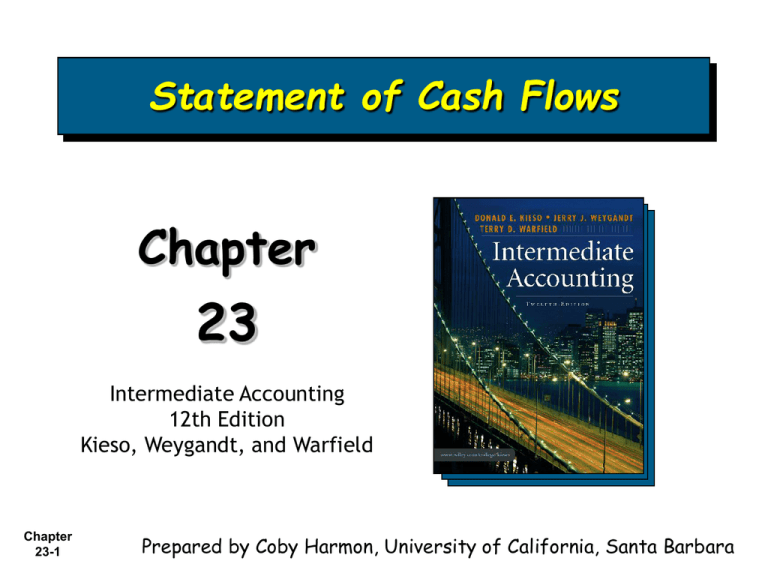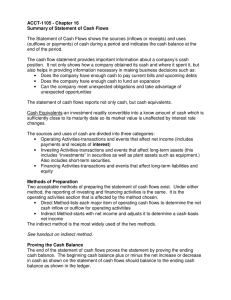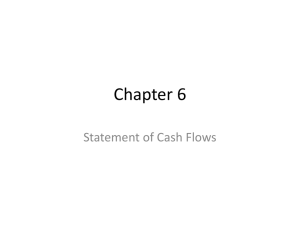
Statement of Cash Flows
Chapter
23
Intermediate Accounting
12th Edition
Kieso, Weygandt, and Warfield
Chapter
23-1
Prepared by Coby Harmon, University of California, Santa Barbara
Learning Objectives
1.
Describe the purpose of the statement of cash flows.
2.
Identify the major classifications of cash flows.
3.
Differentiate between net income and net cash flows from
operating activities.
4.
Contrast the direct and indirect methods of calculating net cash
flow from operating activities.
5.
Determine net cash flows from investing and financing activities.
6.
Prepare a statement of cash flows.
7.
Identify sources of information for a statement of cash flows.
8.
Discuss special problems in preparing a statement of cash flows.
9.
Explain the use of a worksheet in preparing a statement of cash
flows.
Chapter
23-2
Statement of Cash Flows
Preparation of the
Statement
Usefulness
Classification of cash
flows
Format of statement
Steps in preparation
Examples
Sources of information
Indirect vs. direct
method
Chapter
23-3
Special Problems in
Statement
Preparation
Adjustments similar to
depreciation
Accounts receivable (net)
Other working capital
changes
Net losses
Gains
Stock options
Postretirement benefit
costs
Extraordinary items
Significant noncash
transactions
Use of a Worksheet
Preparation of
worksheet
Analysis of
transactions
Preparation of final
statement
Section 1 - Preparation of the
Statement of Cash Flows
Primary purpose:
To provide information about a company’s cash
receipts and cash payments during a period.
Secondary objective:
To provide cash-basis information about the
company’s operating, investing, and financing
activities.
Chapter
23-4
LO 1 Describe the purpose of the statement of cash flows.
Usefulness of the
of Cash Flows
Statement
Provides information to help assess:
1. Entity’s ability to generate future cash flows.
2. Entity’s ability to pay dividends and obligations.
3. Reasons for difference between net income and net
cash flow from operating activities.
4. Cash and noncash investing and financing
transactions.
Chapter
23-5
LO 1 Describe the purpose of the statement of cash flows.
Classification of Cash Flows
Operating
Activities
Income
Statement
Items
Investing
Activities
Generally
Long-Term
Asset Items
The term “Cash” =
Cash and cash equivalents.
Chapter
23-6
Financing
Activities
Generally
Long-Term
Liability
and
Equity Items
LO 2 Identify the major classifications of cash flows.
Classification of Cash Flows
Cash and Cash Equivalent
Text Footnote 3
3 The basis recommended by the FASB for the statement of
cash flows is actually “cash and cash equivalents.” Cash
equivalents are short-term, highly liquid investments that
are both: (a) readily convertible to known amounts of cash,
and (b) so near their maturity that they present insignificant
risk of changes in interest rates. Generally, only investments
with original maturities of three months or less qualify under
this definition. Examples of cash equivalents are Treasury
bills, commercial paper, and money market funds purchased
with cash that is in excess of immediate needs.
Chapter
23-7
LO 2 Identify the major classifications of cash flows.
Classification of Cash Flows
Classification of Typical Inflows and Outflows
Illustration 23-1
Income
Statement
Items
Chapter
23-8
LO 2 Identify the major classifications of cash flows.
Classification of Cash Flows
Classification of Typical Inflows and Outflows
Illustration 23-1
Generally
Long-Term
Asset Items
Chapter
23-9
LO 2 Identify the major classifications of cash flows.
Classification of Cash Flows
Classification of Typical Inflows and Outflows
Illustration 23-1
Generally
Long-Term
Liability and
Equity Items
Chapter
23-10
LO 2 Identify the major classifications of cash flows.
Classification of Cash Flows
Typical
Company
Product Life
Cycle
Chapter
23-11
LO 2 Identify the major classifications of cash flows.
Format of the Statement of Cash Flows
Order of Presentation:
1.
Operating activities.
2.
Investing activities.
3.
Financing activities.
Direct Method
Indirect Method
Report inflows and outflows from investing and
financing activities separately.
Chapter
23-12
LO 2 Identify the major classifications of cash flows.
Steps in Preparation
Three Sources of Information:
1. Comparative balance sheets
2. Current income statement
3. Selected transaction data
Three Major Steps:
Step 1. Determine change in cash.
Step 2. Determine net cash flow from operating activities.
Step 3. Determine net cash flows from investing and
financing activities.
Chapter
23-13
LO 2 Identify the major classifications of cash flows.
Step 2: Determine Net Cash Flow from
Operating Activities
A company must determine revenues and expenses on
a cash basis.
Eliminate the effects of income statement
transactions that do not result in an increase or
decrease in cash.
Convert net income to net cash flow from operating
activities through either a direct method or an
indirect method.
Chapter
23-14
LO 3 Differentiate between net income and net
cash flows from operating activities.
Example – Operating Section
Indirect Method
Adjusts net income for items not affecting cash.
Illustration 23-8
Common adjustments to Net Income (Loss):
Depreciation and amortization expense.
Gain or loss on disposition of long-term assets.
Change in current assets and current liabilities.
Chapter
23-15
LO 4 Contrast the direct and indirect methods of calculating
net cash flow from operating activities.
E23-6 (Operating Activities—Indirect Method)
Krauss Company’s financial statements for the year ended December
31, 2007, contained the following condensed information.
Revenues from fees
Operating expenses
Depreciation expense
Loss on sale of equipment
Income before income tax
Income tax
Net income
Accounts receivable
Accounts payable
Income taxes payable
Chapter
23-16
2007
$ 840,000
624,000
60,000
26,000
130,000
40,000
$ 90,000
$
37,000
41,000
4,000
2006
Change
$ 54,000
31,000
8,500
$ (17,000)
10,000
(4,500)
LO 4 Contrast the direct and indirect methods of calculating
net cash flow from operating activities.
E23-6 (Operating Activities—Indirect Method)
Prepare the operating activities section of the statement of
cash flows using the indirect method (Step 2).
Cash flows from operating activities
Net income
Adjustment to reconcile net income
to net cash provided by operating activities:
Depreciation expense
Loss on sale of equipment
Decrease in accounts receivable
Increase in accounts payable
Decrease in income taxes payable
Net cash provided by operating activities
Chapter
23-17
$ 90,000
60,000
26,000
17,000
10,000
(4,500)
198,500
LO 4 Contrast the direct and indirect methods of calculating
net cash flow from operating activities.
Example – Operating Section
Direct Method
Deducts operating cash disbursements from
operating cash receipts.
Illustration 23-6
“Net cash provided by operating activities” is the
equivalent of cash basis net income.
Chapter
23-18
LO 4 Contrast the direct and indirect methods of calculating
net cash flow from operating activities.
E23-5 (Operating Activities—Direct Method)
Krauss Company’s financial statements for the year ended December
31, 2007, contained the following condensed information.
Revenues from fees
Operating expenses
Depreciation expense
Loss on sale of equipment
Income before income tax
Income tax
Net income
Accounts receivable
Accounts payable
Income taxes payable
Chapter
23-19
2007
$ 840,000
624,000
60,000
26,000
130,000
40,000
$ 90,000
$
37,000
41,000
4,000
2006
Change
Assume accounts
payable relates
to operating
expenses.
$ 54,000
31,000
8,500
$ (17,000)
10,000
(4,500)
LO 4 Contrast the direct and indirect methods of calculating
net cash flow from operating activities.
E23-5 (Operating Activities—Direct Method)
Prepare the operating activities section of the statement of
cash flows using the Direct method (Step 2).
Illustration 23-22
Computation of cash receipts from customers:
Revenue from fees
Add: Decrease in accounts receivable
Cash receipts from customers
Chapter
23-20
$ 840,000
17,000
$ 857,000
LO 4 Contrast the direct and indirect methods of calculating
net cash flow from operating activities.
E23-5 (Operating Activities—Direct Method)
Prepare the operating activities section of the statement of
cash flows using the Direct method (Step 2).
Alternate computation of cash receipts from customers:
Accounts receivable, balance 2006
Add: Revenue from fees
Deduct: Cash receipts from customers
Accounts receivable, balance 2007
Chapter
23-21
$
54,000
840,000
(857,000)
$ 37,000
LO 4 Contrast the direct and indirect methods of calculating
net cash flow from operating activities.
E23-5 (Operating Activities—Direct Method)
Prepare the operating activities section of the statement of
cash flows using the Direct method (Step 2).
Computation of cash payments for operating expenses:
Operating expenses
Deduct: Increase in accounts payable
Cash payments for operating expenses
$ 624,000
(10,000)
$ 614,000
or
Accounts payable, balance 2006
Add: Operating expenses
Deduct: Cash payments for operating expenses
Accounts payable, balance 2007
Chapter
23-22
31,000
624,000
(614,000)
$ 41,000
$
LO 4 Contrast the direct and indirect methods of calculating
net cash flow from operating activities.
E23-5 (Operating Activities—Direct Method)
Prepare the operating activities section of the statement of
cash flows using the Direct method (Step 2).
Computation of cash payments for income taxes:
Income tax expense
Add: Decrease in income tax payable
Cash payments for income taxes
$
$
40,000
4,500
44,500
or
Income tax payable, balance 2006
Add: Income tax expense
Deduct: Cash payments for income taxes
Income tax payable, balance 2007
Chapter
23-23
8,500
40,000
(44,500)
4,000
$
$
LO 4 Contrast the direct and indirect methods of calculating
net cash flow from operating activities.
E23-5 (Operating Activities—Direct Method)
Prepare the operating activities section of the statement of
cash flows using the Direct method (Step 2).
Cash flows from operating activities
Cash receipts from customers
Cash paid for operating expenses
Cash paid for income taxes
Net cash provided by operating activities
Chapter
23-24
$ 857,000
(614,000)
(44,500)
198,500
LO 4 Contrast the direct and indirect methods of calculating
net cash flow from operating activities.
Step 3: Determine Net Cash Flow from
Investing and Financing Activities
E23-2 (a) Plant assets that had cost $20,000 6 years
before and were being depreciated on a straight-line basis
over 10 years with no estimated scrap value were sold for
$5,300.
Plant assets (cost)
$ 20,000
Accumulated depreciation ([$20,000 / 10] x 6)
12,000
Book value at date of sale
8,000
Sale proceeds
Loss on sale
Chapter
23-25
LO 5
(5,300)
$
2,700
Determine net cash flows from investing and financing activities.
E23-2 (a)
Statement of Cash Flows
O
Cash flow from operating activities
Net income
Adjustment to reconcile net income to cash:
Loss on sale
Cash from operations
I
Cash flow from investing activities
Proceeds from sale of plant asset
Cash from investing activities
F
2,700
5,400
Cash flow from financing activities
Cash from financing activities
Net Change in Cash
Chapter
23-26
$
LO 5
$
Determine net cash flows from investing and financing activities.
E23-2 (b)
E23-2 (b) During the year, 10,000 shares of common
stock with a stated value of $10 a share were issued
for $43 a share.
Shares sold
Chapter
23-27
10,000
Market value per share
$
Value of shares
$430,000
LO 5
43
Determine net cash flows from investing and financing activities.
E23-2 (b)
Statement of Cash Flows
O
Cash flow from operating activities
Net income
Adjustment to reconcile net income to cash:
$
Cash from operations
I
F
Cash flow from investing activities
Cash from investing activities
Cash flow from financing activities
Sale of common stock
Cash from financing activities
Net Change in Cash
Chapter
23-28
LO 5
430,000
$
Determine net cash flows from investing and financing activities.
E23-2 (d)
E23-2 (d) The company sustained a net loss for the
year of $50,000. Depreciation amounted to $22,000,
and a gain of $9,000 was realized on the sale of land
for $39,000 cash.
Chapter
23-29
LO 5
Determine net cash flows from investing and financing activities.
E23-2 (d)
Statement of Cash Flows
O
Cash flow from operating activities
Net loss
Adjustment to reconcile net income to cash:
Depreciation expense
Gain on sale
Cash from operations
I
Cash flow from investing activities
Sale of land
Cash from investing activities
F
22,000
(9,000)
39,000
Cash flow from financing activities
Cash from financing activities
Net Change in Cash
Chapter
23-30
$ (50,000)
LO 5
$
Determine net cash flows from investing and financing activities.
E23-2 (h)
E23-2 (h) During the year, treasury stock costing
$47,000 was purchased.
Chapter
23-31
LO 5
Determine net cash flows from investing and financing activities.
E23-2 (h)
Statement of Cash Flows
O
Cash flow from operating activities
Net income (loss)
Adjustment to reconcile net income to cash:
Cash from operations
I
Cash flow from investing activities
Cash from investing activities
F
Cash flow from financing activities
Purchase of company stock
Cash from financing activities
Net Change in Cash
Chapter
23-32
LO 5
(47,000)
$
Determine net cash flows from investing and financing activities.
Statement of Cash Flows (a,b,d,h)
Statement of Cash Flows
O
Cash flow from operating activities
Net income (loss)
Adjustment to reconcile net income to cash:
Depreciation expense
Loss on sale
Gain on sale
Cash from operations
$ (50,000)
22,000
2,700
(9,000)
(34,300)
Cash flow from investing activities
I
F
Cash flow from financing activities
Sale of common stock
Purchase of company stock
Cash from financing activities
Net Change in Cash
Chapter
23-33
5,400
39,000
44,400
Sale of plant assets
Sale of land
Cash from investing activities
430,000
(47,000)
383,000
$ 393,100
LO 6 Prepare a statement of cash flows.
Sources of Information for the
Statement of Cash Flows
1. Comparative balance sheets.
2. An analysis of the Retained Earnings.
3. Writedowns, amortization charges, and similar
“book” entries, such as depreciation, because they
have no effect on cash.
Chapter
23-34
LO 7 Identify sources of information for a statement of cash flows.
Net Cash Flow from Operating Activities—
Indirect Versus Direct Method
Net Income
Indirect Method
Chapter
23-35
LO 7 Identify sources of information for a statement of cash flows.
Net Cash Flow from Operating Activities—
Indirect Versus Direct Method
Under the Direct Method, companies adjust each item
in the income statement from the accrual basis to the
cash basis.
Example line items found in the operating section:
Cash receipts from customers (see E23-5)
Cash payments to suppliers (see E23-4 to follow)
Cash payments for operating expenses (see E23-5)
Cash payments for income taxes (see E23-5)
Chapter
23-36
LO 7 Identify sources of information for a statement of cash flows.
BE23-4 (Direct Method)
BE 23-4 Azure Corporation’s financial statements for 2008,
contained the following condensed information (some facts
added).
Sales
Cost of goods sold
Operating expenses
Depreciation expense
Net income
Inventory
Accounts payable
2008
$ 200,000
120,000
29,000
21,000
$ 30,000
$
65,000
44,000
2007
Change
$ 54,000
31,000
$ 11,000
13,000
Calculate “Cash Payments to Suppliers.”
Chapter
23-37
LO 7 Identify sources of information for a statement of cash flows.
BE23-4 (Direct Method)
Illustration 23-23
Computation of cash payments to suppliers:
Cost of goods sold
Add: Increase in inventory
Purchases
Deduct: Increase in accounts payable
Deduct: Cash payments to suppliers
Chapter
23-38
$ 120,000
11,000
131,000
(13,000)
$ 118,000
LO 7 Identify sources of information for a statement of cash flows.
BE23-4 (Direct Method)
Alternate Computation of cash payments to suppliers:
Inventory, balance 2007
Add: Purchases
Deduct: Cost of good sold
Inventory, balance 2008
54,000
131,000
(120,000)
$ 65,000
$
and
Accounts payable, balance 2007
Add: Purchases
Deduct: Cash payments to suppliers
Accounts payable, balance 2008
Chapter
23-39
31,000
131,000
(118,000)
$ 44,000
$
LO 7 Identify sources of information for a statement of cash flows.
Direct Versus Indirect Controversy
In Favor of the Direct Method
Shows operating cash receipts and payments.
Information about cash receipts and payments is
more revealing of a company’s ability
Chapter
23-40
1.
to generate sufficient cash from operating
activities to pay its debts,
2.
to reinvest in its operations, and
3.
to make distributions to its owners.
LO 7 Identify sources of information for a statement of cash flows.
Direct Versus Indirect Controversy
In Favor of the Indirect Method
Focuses on the differences between net income
and net cash flow from operating activities.
Provides link between the statement of cash flows
and the income statement and balance sheet.
Special Rules Applying to Indirect Methods
Disclose Interest paid.
Disclose Income taxes paid.
Chapter
23-41
LO 7 Identify sources of information for a statement of cash flows.
Special Problems in Statement Preparation
1. Adjustments similar to depreciation
Amortization of limited-life intangible assets.
Amortization of deferred costs.
Amortization of bond discount or premium.
Changes in deferred income taxes.
Change related to an investment when recording
income or loss under the equity method.
Chapter
23-42
LO 8 Discuss special problems in preparing a statement of cash flows.
Special Problems in Statement Preparation
2. Accounts receivable, net
3. Other working capital changes
4. Net losses
5. Gains
6. Stock options
7. Postretirement benefits
8. Extraordinary items
9. Significant noncash transactions
Chapter
23-43
LO 8 Discuss special problems in preparing a statement of cash flows.
Use of a Worksheet
A worksheet involves the following steps.
Step 1. Enter the balance sheet accounts and their
beginning and ending balances in the balance sheet accounts
section.
Step 2. Enter the data that explain the changes in the
balance sheet accounts and their effects on the statement
of cash flows in the reconciling columns of the worksheet.
Step 3. Enter the increase or decrease in cash on the cash
line and at the bottom of the worksheet. This entry should
enable the totals of the reconciling columns to be in
agreement.
Chapter
23-44
LO 9 Explain the use of a worksheet in preparing a statement of cash flows.
Copyright
Copyright © 2007 John Wiley & Sons, Inc. All rights reserved.
Reproduction or translation of this work beyond that permitted
in Section 117 of the 1976 United States Copyright Act without
the express written permission of the copyright owner is
unlawful. Request for further information should be addressed
to the Permissions Department, John Wiley & Sons, Inc. The
purchaser may make back-up copies for his/her own use only
and not for distribution or resale. The Publisher assumes no
responsibility for errors, omissions, or damages, caused by the
use of these programs or from the use of the information
contained herein.
Chapter
23-45








